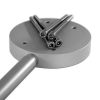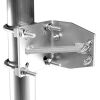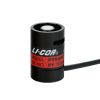Kipp & Zonen SMP Series Smart Pyranometers
Features
- Internal digital signal processing and interfaces for industrial applications
- Automatic correction for temperature dependence of the detector sensitivity
- Built-in bubble levels and adjustable leveling feet
- Expedited repair and warranty service
- Lifetime technical support
- More
Overview
The Kipp & Zonen SMP Series Smart Pyranometers are high-quality radiometers designed for measuring short-wave irradiance on a plane surface (radiant flux, W/m²), which results from the sum of the direct solar radiation and the diffuse sky radiation incident from the hemisphere above the instrument.
Integration
SMP pyranometers feature internal digital signal processing and interfaces optimized for industrial data acquisition and control systems. Kipp & Zonen has developed a smart interface that features RS-485 Modbus data communication for connection to programmable logic controllers (PLC’s), inverters, digital control equipment and the latest generation of data loggers. Amplified Voltage or Current outputs are also included for devices that have high-level analog inputs or current loop interfaces.
Model Options
All models are available in two versions. One has an analog voltage output of 0 to 1 V, and the other has an analog current output of 4 to 20 mA. They all have a 2-wire RS-485 interface with Modbus (RTU) protocol. Digital signal processing provides faster response times and, with an integrated temperature sensor, corrects for the temperature dependence of the detector sensitivity.
Design
To achieve the required spectral and directional characteristics, SMP Series pyranometers use thermopile detectors and glass domes. All SMPs have built-in bubble levels and adjustable leveling feet. Snap-on sun shields reduce solar heating of the housings. The waterproof connectors have gold-plated contacts.
In The News
Source Water Monitoring in Albany, New York: Tracing Water Quality throughout Tributaries
Thousands of US cities pull their drinking water from natural source waters like reservoirs, rivers, and streams, making overall watershed health a key consideration for water providers. In Albany, New York, the Albany Department of Water and Water Supply delivers drinking water to over 100,000 residents as well as monitors and manages the larger drinking water supply watershed. Hannah Doherty, Environmental Specialist at the Albany Department of Water and Water Supply , spends her days working with a small team to monitor the drinking supply and the connected water bodies. Doherty explains, “We’re the first to encounter the water that ends up being the drinking water.
Read MoreWildfire Prevention in the Sierra Nevada Region with the Yuba Watershed Institute
Though recent wildfires have sparked new conversations about wildfire management and response, groups like the Yuba Watershed Institute have been monitoring the forests and water resources of the Sierra Nevada region for decades, managing approximately 5,000 acres of land with the Bureau of Land Management (BLM) and about 7,000 acres in private land partnerships. The goal of the Institute is to work with local communities and land agencies to improve watershed and forestry management through informed practices and public outreach. The goals of the Yuba Watershed Institute are three-fold: Improve the ability of fire suppression agencies like the California Department of Forestry and Fire Protection ( CAL FIRE ) and the US Forest Service.
Read MoreWave Sensors Integration with NexSens Buoys: A Cutting-Edge Solution for Wave Measurment
Real-time wave data supports accurate weather prediction, safe and efficient maritime operations, and provides valuable safety and operating condition information for recreation and commercial fishing. Understanding wave dynamics also helps with the design of protective coastal structures like seawalls, breakwaters, and jetties. It also supports better prediction of their impact on sediment transport and coastal geomorphology. Wave data is a key factor in qualifying and designing offshore wind farms and harnessing kinetic energy for electrical generation. It helps with the understanding of ocean-atmosphere interactions and contributes to studies of sea-level rise and climate change impacts.
Read More
























